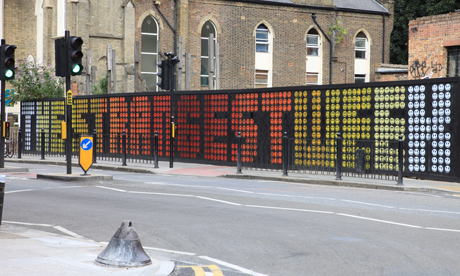Street art tours reveal hidden treasure

Ben Eine, The Strangest Week. Photograph: Steve Cotton/artofthestate.co.uk
Unlabelled, largely uncontrolled and impermanent, street art is hard to categorise or capture. Which is why self-confessed fan Richard Howard-Griffin is taking me on the street art tour he runs around London’s East End, where the wall paintings, pasted-up drawings and sculptures crowd thickly over doors, walls and shop shutters – often only fleetingly considered by passersby.
Griff, as he prefers to be known, says his walking tours help enthusiasts attune their eyes to what’s around them. “I’m preparing people to find it for themselves,” he says. It’s true: by the end of our tramp my taxonomical skills have reached a level where I can tell a Stik from a Roa from a Swoon from an Invader. After a while, you begin to “see” street art, just as an experienced birdwatcher will spot rare species that flit unnoticed past the vision of the uninitiated.
Street art is, arguably, hovering on the verge of mainstream recognition. Works may still routinely be painted over by unfriendly councils – a process known as “buffing” – but last week MOCA, Los Angeles’s contemporary art museum, opened a major survey of street art, documenting its development from the 1970s to the present.
And it was a canvas by Eine – who makes large painted slogans on shutters and walls – that was given as a gift by the prime minister, David Cameron, to Barack Obama last year: an act commemorated by the artist in a mural on Hackney Road that reads, simply: STRANGEST WEEK.
The first stop on the tour is the now empty Foundry on London’s Old Street. Much mourned, the former gallery and pub is due to be demolished and replaced by a hotel.
On its side wall, protected by wooden hoarding, is a large Banksy, which will be incorporated into the lobby of the new building. The wooden hoarding itself has been painted over by the Brazilian artist Zezão, which in turn has been covered by plastic sheeting to protect it as the wall surface above is prepared for a fresh work by another street artist.
At the back of the scrappy car park a sculpture of a green fungus by Christiaan Nagel sprouts modestly. Nagel recently braved the waters of the Serpentine to place brightly coloured giant mushrooms atop a line of posts that protrude from the lake. They didn’t last long.
The protection of the Banksy is characteristic, according to Griff. “If you see a bit of street art behind Perspex, it tends to be a Banksy,” he says. Indeed, the other murals – there is also a giant weasel by the Belgian artist Roa, among others – are welcome here. These are “legal walls”.
Most street art, though, is less protected. As we tramp the streets, Griff repeatedly points out the shiny black paint that represents recent “buffing”; and shows me fragments of coloured paint – as faint as traces of polychrome on antique statues – by doorsteps and gutters that are the traces of street art past.
There are “carcasses”, too, of works by Invader: little patches of white adhesive are often all that remain of the artist’s mosaics, in ceramic tiles, representing computer-game space invaders. When complete, they seem to stare discreetly at passersby, keeping the street under quiet surveillance. Like many street artists, Invader’s work is international: there have been “invasions” of Rotterdam, Vienna, Los Angeles, Manchester and even Kathmandu.
We dip down into a dark alley called Blackall Street and a forest of art confronts us. Out of the gloom shine neon-bright monsters painted on newspaper and pasted to the wall by Bortusk Leer. And, lurking above some metal steps embellished with what may or may not be human faeces, there are some topical pieces, by an artist unknown even to Griff: the slogan U R SO PORNO BABY is stencilled over pages of the Sun newspaper featuring pictures of Prince William and Kate Middleton.
Nearby is an impressive pasted-up image of a woman by the American artist Swoon. “You can’t bracket her as a street artist,” says Griff. Her work is owned by museums including Tate; in 2009 she mounted a high-profile, if eccentric, project to sail vessels made of New York refuse from Slovenia to the Venice Biennale. For such artists, the work they make on the street may be prey to opportunistic thieves as much as the black paint of councils.
On Curtain Road a slim, long-haired figure in jeans is spray-painting an image of a woman’s face on to metal shutters. This is David Walker, who, as his relaxed demeanour suggests, is working on a “legal” site. News of fresh street art travels fast on Twitter and Facebook: he has been working for only half a morning and already a handful of fans have pitched up.
Ten years ago, he says, “You’d do pop-up shows, about 30 people would come and you’d end up swapping your art with friends.” Now, the scene is very different: he has just come back from a solo show of his work at the Galerie La Tour in Paris: “I’ve just spent a month in the bougiest part of Paris – now I’m out in the grimiest patch of Shoreditch,” he says. He grins, and picks up his spray cans again.
London street-art walking tours take place on Saturdays and Thursdays streetartlondon.co.uk/tours/
guardian.co.uk © Guardian News & Media Limited 2010
Published via the Guardian News Feed plugin for WordPress.
